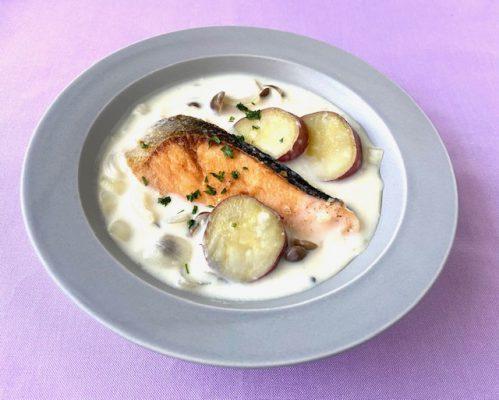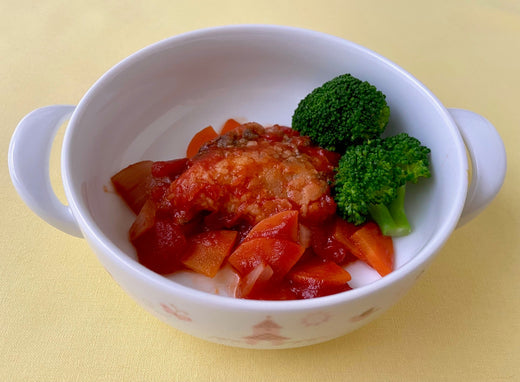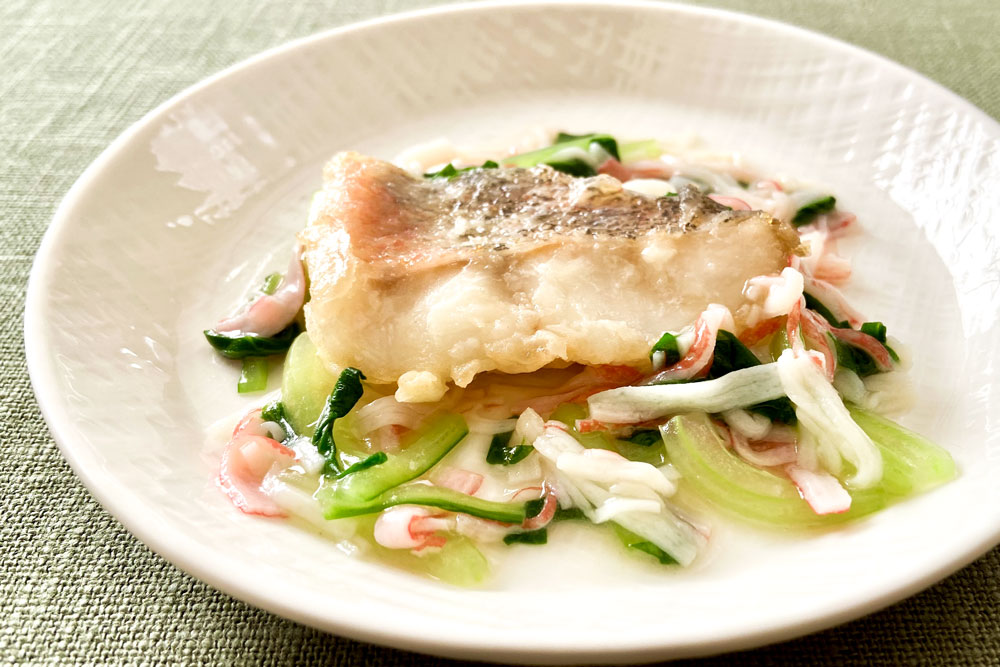Fish Dictionary | Alfonsino and other red fish
Here's what makes Okafoods' alfonsino and red fish so great!
✓ Number 1: We have devised a way to ensure that the skin color is consistent!
If the skin is scratched during fishing and the scales peel off, the skin will turn whitish. The condition of the skin will vary depending on the fishing boat. Alfonsino and other red fish are caught in deep-sea fishing using the trawl method, and if the cycle of fishing → processing on board (removal of heads and organs) → freezing is repeated in a short period of time, the scales will peel off less. Conversely, even with the same trawl fishing method, if a large number of fish are placed in the net over a long period of time and then landed all at once, the fish will interfere with each other, causing the scales to peel off and resulting in a tendency for the skin color to vary widely. The key to inspecting raw materials before purchasing is to inspect each lot based on the ship's daily catch report, including days with high, low, and average catches.For example, we check to see if there is a large variation in quality before purchasing, such as whether the catch is too large and it takes too long to process and freeze on board, resulting in a loss of freshness, or conversely, whether the catch is too small and the onboard processing date has been postponed, resulting in a loss of freshness.
✓ Number 2: We have devised a way to ensure that the skin color is consistent!
If the fish dries out during freezing, the color of the skin will fade and turn whitish. Therefore, after catching, the fish are frozen on board using a process called "glazing," which involves applying a thick layer of ice to the surface of the fish to prevent discoloration due to drying.
✓ Number 3: We are committed to freshness!!
The fishing boats are like mobile processing factories, and after the fish are caught, they are processed into raw materials (cutting the head and removing the internal organs), sorted by size, and frozen on board using machines to efficiently maintain the freshness of the fish before quickly storing it in the freezer. However, in the event of a good catch, it is expected that it will take some time for the fish to freeze, so when purchasing raw materials, we inspect them based on the daily fishing report.
☝Fun facts about alfonsino
It's a brightly colored and eye-catching fish... It is an inconspicuous presence in the ocean!!

The alfonsino is characterized by its glossy red body and large golden eyes, and its vibrant color and fatty white flesh make it an essential fish for celebratory banquets.
-When pulled out of the sea, this fish stands out with its bright red skin, but at the bottom of the ocean where it lives, the red color of sunlight is absorbed, so it appears an inconspicuous black color to protect itself from predators.
・There are over 200 types of fish that have the name "tai" (sea bream), but most of them have nothing to do with "sea bream." Fish in the Sparidae family are limited to a few species such as red sea bream and crimson sea bream. The alfonsino is a member of the Alfonsino family and has golden eyes and a red body like red sea bream, so it is called "kinmedai" (golden-eyed snapper) even though it is not a member of the Sparidae family.
☝Fun facts about red fish (other than alfonsino)
The names are different though... They have similar colors and facial features, and are all members of the same family!!
Ocean rockfish, rockfish, redfish, and Atlantic redfish are all members of the same family, Scorpaenidae (family Scorpaenidae), genus Sebastes, and are rare among fish in that they are ovoviviparous. Ovoviviparous fish do not give birth to offspring from eggs, but rather hatch and grow to a certain extent inside the parent fish before being born.
-The eyes of these red fish (other than alfonsino) bulge out due to the water pressure when they are caught by trawling, giving them a wide, staring look.
- Common characteristics include a sharp dorsal fin and red lenticels.
Characteristics of alfonsino and red fish
The dorsal fins of red fish are very sharp, and often pierce and break the bodies of other fish when they are caught. These bones are often found in areas where there are no bones, making them difficult to detect with standard bone residue inspections. To prevent such bones from getting mixed in, we conduct X-ray inspections after the removal process.

How to name seafood
✓ No. 1: Can names according to the growth stage and season be displayed on the menu?
The same fish can be called by different names, such as mature fish (e.g., Mojako (juvenile fish) → Wakashi (up to about 30 cm) → Inada (up to about 50 cm) → Warasa (up to about 90 cm) → Yellowtail (over 90 cm)), seasonal names (e.g., Akisake/Akiaji (fish that migrate to the coast to spawn in autumn), Tokisake/Tokisakerazu (fish that migrate to the coast from spring to early summer)). For commonly understood fish, the name according to their growth stage and season can be displayed.
Furthermore, with regard to the product names and names of grown fish, inada may be sold as buri and Spanish mackerel as sawara, but according to the Fisheries Agency's "Guidelines for the Name of Seafood," the standards for grown fish have not yet been clearly defined, so at present, the method of labeling is left up to each seller and menu decision maker.
✓ No. 2: The collective name of "Plus Menuke Fillet" is "Aomebaru" (Blue Rockfish), but is it different from "Menuke"?
The collective name "Aomebaru" is the standard Japanese name, but as it is an unfamiliar standard Japanese name, the common trade name "Menuke" has been used as the product name to make it easier for consumers to understand. We use the general distribution name that reflects the product's contents as the product name, but the name displayed as a whole is the standard Japanese name or the common name. We are careful to avoid confusing consumers by using unfamiliar standard Japanese names as product names.
✓ Number 3: It is important to display the menu in a way that does not mislead people into thinking the product is of a high quality!
When we say "menu," it can be broadly divided into dining out menus at restaurants and hotels, etc., and menus for facilities (nursing homes, hospitals, etc.). Menus when eating out: Consumers look at the menu, make a selection, and eat. In such cases, they must decide on a menu in accordance with the Act against Unjustifiable Premiums and Misleading Representations. Menus at facilities: It is assumed that consumers will eat what is provided by the facility rather than choosing from a menu. In such cases, the menu names must be designed to make the meal enjoyable, without misleading consumers. Furthermore, when deciding on labeling, any labeling that could mislead consumers into believing the product is of a higher quality is prohibited. If you are unsure, please refer to the "Name of the All-in-One Label" on the package and the "Fisheries Agency's Guidelines for Seafood Names," and if you have any concerns, we recommend checking with the "Consumer Affairs Agency"!! For example, the standard Japanese name "Karafuto Shishamo" is prohibited from being called "Shishamo" because the commercial value of "Karafuto Shishamo" and "(Domestic) Shishamo" is different in the market. * Misidentification (giving a name similar to that of a high-quality fish, even though it is taxonomically unrelated, leading to the misconception that it is a related species)
Okafoods' popular alfonsino

Plus Alfonsino fillet 60g (bone removed)
Alfonsino is known as a luxury fish, and we use only carefully selected fish caught in the clean waters of New Zealand and the Indian Ocean. The delicious flesh and colorful scarlet skin add a touch of elegance to any dish.
Click here for products














